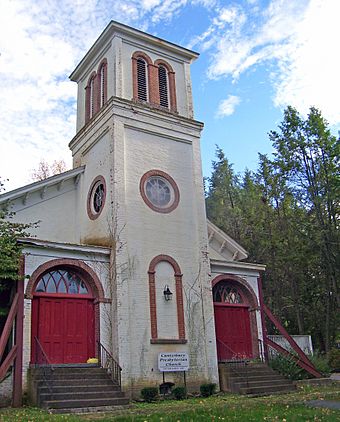Canterbury Presbyterian Church facts for kids
Quick facts for kids |
|
|
Canterbury Presbyterian Church
|
|

Church in 2007
|
|
| Location | Cornwall, NY |
|---|---|
| Nearest city | Newburgh |
| Built | 1826 |
| Architectural style | Federal style |
| MPS | Town of Cornwall Historic and Architectural Resources |
| NRHP reference No. | 96000556 |
| Added to NRHP | 1996 |
The Canterbury Presbyterian Church is a historic building located on Clinton Street in downtown Cornwall, New York, United States. It is made of white stone and brick, built in the Federal style. Later parts were added in a Colonial Revival style, matching the original look. Since 1996, this church has been listed on the National Register of Historic Places, which means it's recognized as an important historical site.
Church services stopped in 2004. The Canterbury church joined with the Cornwall Presbyterian Church. This other church had been started by members who left Canterbury earlier. The building has since been used by different local groups that help the community. In 2018, the church building, which needed repairs, was bought and turned into a dance studio.
Contents
About the Church Building
The Canterbury Presbyterian Church has a special design. It has a three-by-four-bay layout, which means it has a certain number of sections on its sides. It shows features of the Federal style, like windows placed evenly and decorative fanlights above them. The building is one and a half stories tall. A tall bell tower was added later, reaching two stories high. Two main additions were built much later, but they were designed to match the original style of the church.
Inside the Church
Much of the church's inside still looks like it did when it was first built. The way the rooms are laid out has not changed much. Many original items are still there, including the pews (church benches), other furnishings, and the wood panels on the walls.
The Churchyard
Behind the church building is an old churchyard. This area is also considered important to the church's historical listing. About 50 gravestones of people who used to attend the church have been found there. The oldest gravestone dates back to the 1830s.
History of the Church
The first Presbyterian group in the Cornwall area started meeting in 1824. They were known as both the Canterbury congregation and the First Presbyterian Society. The church building itself was finished two years later, in 1826. Then, in 1827, 17 founding members officially formed the First Presbyterian Church in Canterbury. They described themselves as a "small and feeble band."
Growth and Changes
By 1829, the new church had grown a lot, more than tripling in size. In 1856, some members left to start the Cornwall Presbyterian Church. They disagreed with the strong feelings against slavery (called abolitionist views) and the strictness of Jonathan Silliman, who was the church's pastor for a long time.
Nine years later, in 1865, the members who stayed raised money. They used it to build the bell tower and new entrance areas called vestibules. More updates happened in 1891. A local builder named H. R. Taylor was hired to construct a new chapel. This chapel was named after Reverend Jonathan Silliman. At that time, Electric lights were also put into the church's main worship area, called the sanctuary.
Joining and Separating
The Cornwall Presbyterian Church and Canterbury reunited in 1925. However, they separated again in 1957 because of other disagreements. Canterbury responded by adding more to their building in 1961. This new part was called Hagen Hall and was an addition to Silliman Chapel. It had a low gabled roof, similar to the carriage shed it replaced.
Later Years and New Purpose
In the late 1900s, the church's membership became smaller and smaller. It started renting space to groups like the Arts Alliance. This group held movies and dances in the building on weekends, which were popular. But even with these events, it wasn't enough to keep the church going. By 2003, there were only 11 members left. The church walls were so weak that they needed temporary steel supports to hold them up.
The last church services were held on February 15, 2004. This ended 178 years of the church's history. The remaining members joined with the Cornwall Presbyterian Church, which had become the main Presbyterian church in the town. Since then, the Arts Alliance and other non-profit groups have continued to use the building for their activities.
The church building was sold to a couple. They planned to open it as the Canterbury Center. This center would focus on spiritual awareness and healing arts. It would also continue to be available for community groups to use. Some items from the church have been saved. They are now shown at the Cornwall Historical Society's museum at Town Hall.

